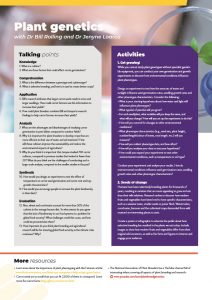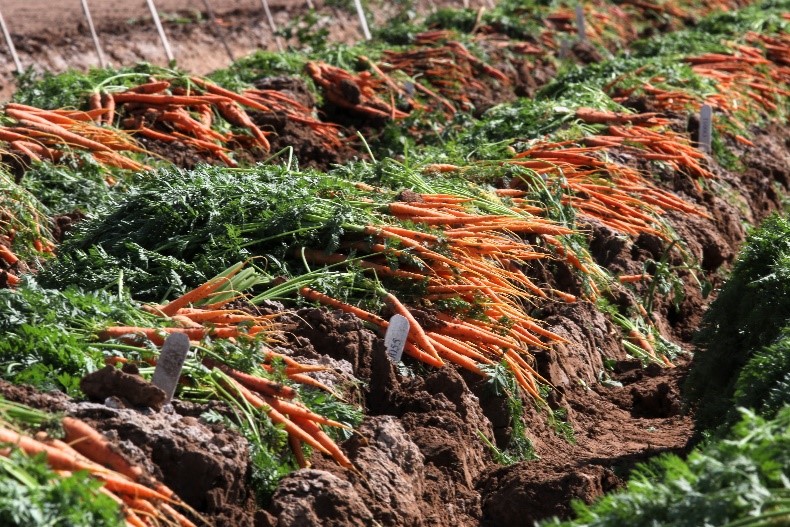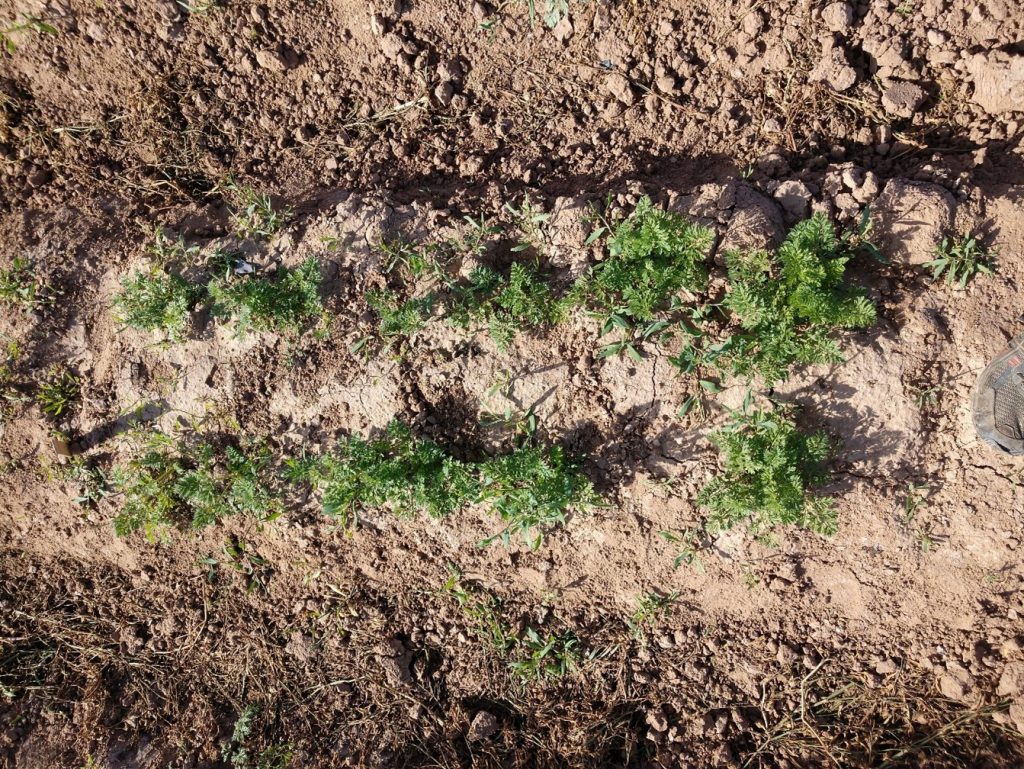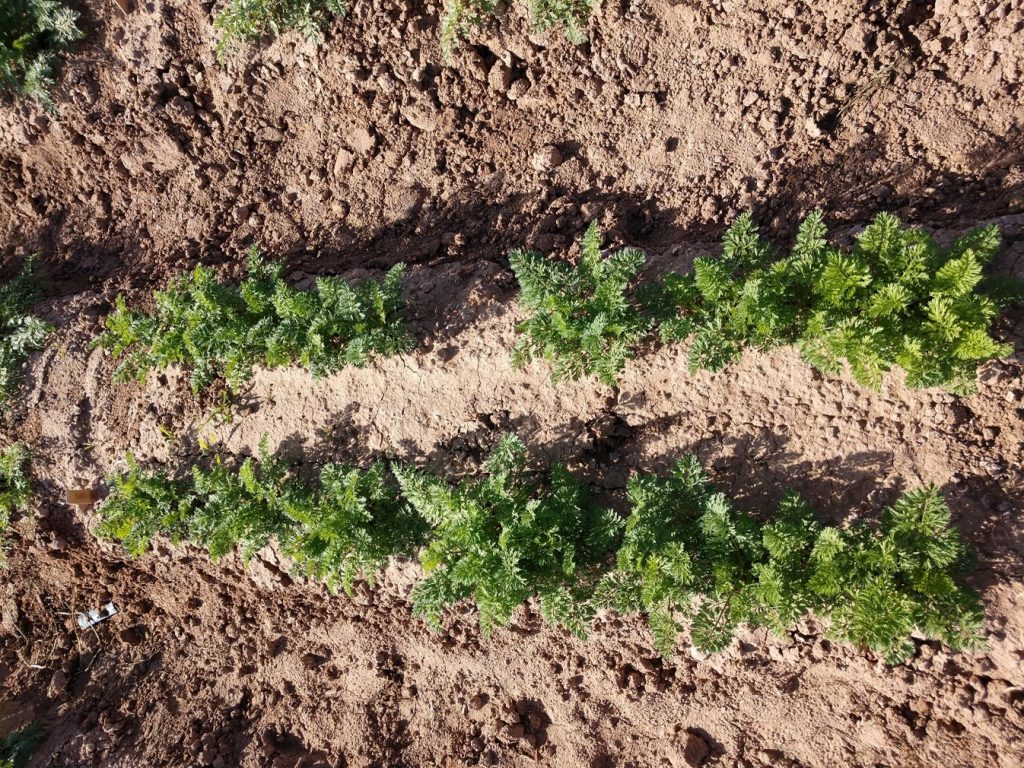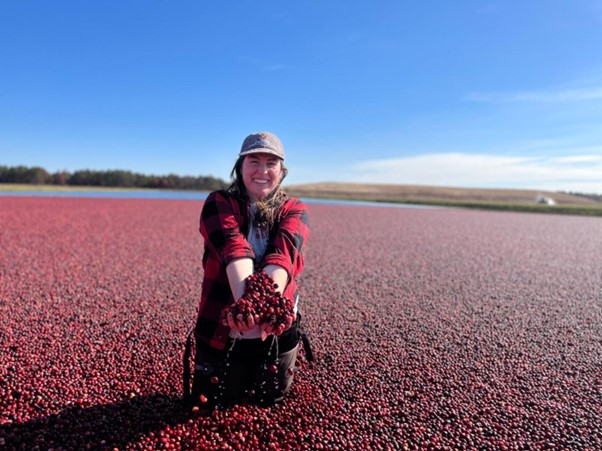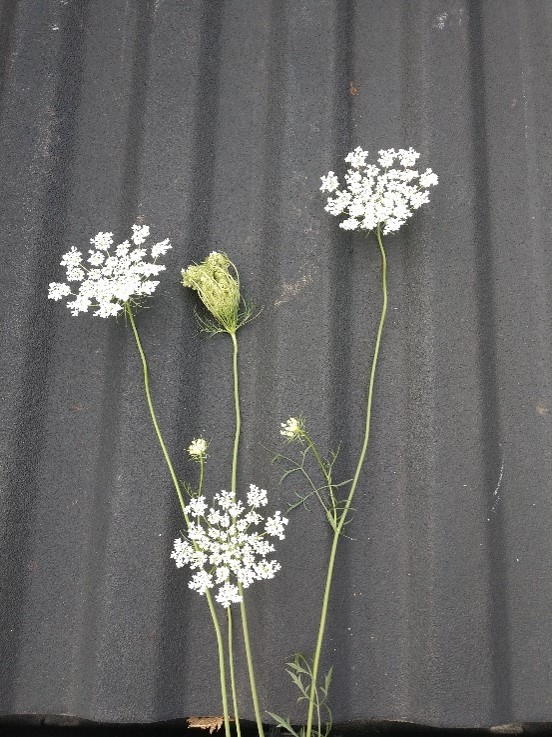Keep calm and carrot on: how can we breed better carrots?
The colourful carrot is one of America’s favourite vegetables, but carrot farmers face many challenges when growing their crops. At the US Department of Agriculture Vegetable Crop Research Unit at the University of Wisconsin-Madison, USA, Dr Bill Rolling and Dr Jenyne Loarca are investigating what influences carrot germination and growth, helping plant breeders to cultivate more successful carrot varieties.
Talk like a plant geneticist
Canopy cover — the area of ground shaded by a plant’s leaves
Crop — a cultivated plant, often grown for food
Cultivar — a variety of a plant species that has been produced by selective breeding
DNA sequencing — the process of determining an organism’s DNA
Food security — having sufficient nutritious food
Genotype — all the genetic material within an organism
Germination — when a seed begins to grow
Herbicide — weed killer
Phenotype — the physical characteristics of an organism
Seedling — a young plant
Selective breeding — when humans deliberately breed plants or animals to have specific desirable characteristics
Top-growth — the above-ground parts of a plant
What is orange, supposedly helps you see in the dark, and is one of America’s favourite vegetables? The answer, of course, is the humble carrot. The average person eats over 10,000 of these tasty and nutritious vegetables in a lifetime. However, while this colourful vegetable is a staple in many people’s diets, carrots can be tricky to grow, owing to their inconsistent germination, slow growth and specific environmental requirements.
In the USDA Vegetable Crop Research Unit, Dr Bill Rolling and Dr Jenyne Loarca are working to improve crop productivity for carrot farmers. Bill is investigating the factors that influence carrot germination, while Jenyne’s research focused on the genetics of carrot growth. Together, their discoveries are helping plant breeders to create more successful carrot cultivars.
What influences carrot germination?
Bill is interested in whether the size of a carrot seed influences its performance. Do larger seeds have a higher chance of germinating? Do they produce healthier seedlings? Do the seedlings grow faster? “Carrot germination is complex,” explains Bill. “It is influenced by the environment, seed quality and genetics.” For example, cold weather can kill carrot seedlings, a lack of moisture can reduce germination, too much water can drown seeds or make seedlings prone to disease, and seeds that have been stored for a long time are less likely to germinate. The unique genetic information contained within each seed determines how well it germinates and grows.
What influences a carrot’s phenotype?
A carrot’s genotype refers to all its genetic material, while its phenotype refers it its physical properties, such as root length, shape and colour. Bill is studying the genotypes of over 700 different carrot cultivars by sequencing their DNA. “Though most of the DNA sequences are the same, each cultivar has small DNA differences which result in differences in the phenotype,” he explains. Plant breeders identify which carrot cultivars have genotypes that produce desirable phenotypes, such as tasty flavours, high nutritional content, and good germination and growth rates.
A carrot’s phenotype is not only affected by its genotype, but also by its environment. For example, planting too many carrots in a small space forces the plants to compete for sunlight and nutrients, preventing them from growing as large as they could, while growing carrots in dense or damp soil can result in diseases that reduce the number of carrots fit for harvest. “Fortunately, carrot farmers are very good at creating an environment where carrots grow well!” says Bill.
How is Bill studying carrot germination?
Before investigating whether seed size influences germination and growth, Bill first wanted to discover whether a carrot’s genotype influences seed size. To do this, he grew carrots in a greenhouse, allowing him to control the growing environment. As the carrots were all grown under the same conditions, most variations in phenotype result from the cultivar’s genotype rather than the environment.
Once these greenhouse-grown carrot plants had flowered, Bill harvested the seeds and used them for the next stage of his research. By measuring the size of the seeds produced by different cultivars and sequencing their DNA, he can now investigate the relationship between genotype and seed size.
Bill is also using these harvested seeds for germination and growth experiments. To study the relationship between seed size, genotype and germination, he is growing carrot seeds in petri dishes in the lab. “Growing seeds in petri dishes allows us to have a large-scale experiment, because petri dishes don’t take up a lot of space, and we can quickly observe the number of seeds that have germinated,” Bill explains. He can also meticulously control environmental conditions, such as temperature and moisture within the petri dishes, giving a better estimate of how non-environmental factors, such as seed size and genotype, influence germinate rates.
Bill has also planted some of the seeds outdoors in fields to discover how well they germinate and grow under real-world conditions. This is important because carrot farmers do not grow their carrots in petri dishes, but in fields where environmental conditions are less easy to control. “It’s important to test if what you’re seeing in the lab under controlled growth environments remains true in the field,” Bill explains.
What has Bill discovered?
“We are currently in the process of determining if seed size is a phenotype that is related to genotype, or if the environment the seeds are produced in is the key determining factor,” says Bill. The preliminary results from his germination and growth experiments suggest that larger seeds are more likely to germinate and grow into larger seedlings. If he discovers that seed size is controlled by genotype, then selective breeding could be used to grow carrot plants that produce larger seeds, benefiting farmers by providing cultivars that germinate and grow more successfully.
What influences carrot top-growth?
Reference
https://doi.org/10.33424/FUTURUM412
While we, as consumers, are interested in the carrot’s root, as this is the part of the plant we eat, Jenyne wanted to understand the relationship between a carrot’s genotype and its top-growth characteristics, as it is the above-ground part of the carrot plant that competes with weeds for sunlight. This is especially important for organic farmers, who are not allowed to spray herbicides to remove weeds. To do this, Jenyne grew 700 different carrot cultivars in a field. Previous studies had compared fewer than 20 carrot varieties, and this was the first study to investigate such an extensive range of carrots.
Jenyne and her team collected measurements of different phenotype characteristics throughout the growing season, such as top-growth height and canopy cover. From these data, Jenyne used statistical techniques to explore the relationships between these characteristics. Then, by combining the phenotype data with genotype data from the different cultivars, they determined that top-growth phenotype variation is due largely to genetics, rather than environmental influence, and they discovered the specific genes that result in specific top-growth characteristics that outperform weeds. Furthermore, Jenyne found that that some of the seed traits that Bill studies affect top-growth phenotypes, with larger seeds producing taller top-growth.
What are the benefits of Bill and Jenyne’s research?
Carrots are notorious for their slow and inconsistent germination and growth, which can cause problems for farmers. “Carrot growers have highlighted that improved germination and growth would be helpful to them,” says Bill. “We hope to apply our research to carrot breeding programmes, to provide cultivars that perform better early in the growing season with faster and more consistent germination and seedling growth.”
“Uncovering the genetic causes of top-growth characteristics was an important finding,” says Jenyne. “It means we can select the best-performing carrots to use as breeding parents to create new carrot varieties that have more vigorous top-growth. These new cultivars will especially help organic farmers, as the plants will naturally outcompete weeds without the need for herbicides.”
But this research is not just important for carrot farmers. “Carrots are a very nutritious crop,” explains Bill. They are a good source of the nutrients that help our bodies make vitamin A, which is needed to keep our eyes and immune system healthy. “To achieve global food security, we must produce enough calories and nutrients for everyone in a sustainable way, while also ensuring farmers can make a living.” Bill and Jenyne hope their research will do just that.
 Dr Bill Rolling
Dr Bill Rolling
Dr Jenyne Loarca
US Department of Agriculture Vegetable Crop Research Unit, Department of Horticulture, University of Wisconsin-Madison, USA
Fields of research: Plant Genetics, Plant Breeding
Research project: Investigating the factors that influence carrot germination and growth
Funder: This work is supported by the US Department of Agriculture National Institute of Food and Agriculture (USDA-NIFA), award number 5090-21000-069-061-I. The contents are solely the responsibility of the authors.
About plant genetics
It was through plants that scientists first discovered the concept of genetics. Gregor Mendel, a 19th century biologist, grew peas and studied the ways in which offspring inherited characteristics from their parent plants. Mendel’s discoveries still form the basis of genetics to this day.
Plant genetics has important real-world applications, particularly in agriculture. Through selective breeding, plant geneticists can create crop varieties that are more suited to our purposes than their wild relatives. For example, broccoli, cauliflower and cabbage are all derived from wild mustard. By selectively breeding for specific characteristics, such as the size of the buds, flowers or leaves, farmers have produced many different vegetables from one species of wild plant.
How can plant genetics address global food security?
“Did you know that of the 320,000 plant species known to science, more than 50% of the human diet is composed of only three species?!” asks Jenyne. While our ancient ancestors ate around 6,000 plant species, today, humans only cultivate 150-200 species, and just nine of these provide more than two thirds of total crop production! Can you guess what these nine key crops are?* “This means there is a lack of biodiversity in global food systems, so agricultural research is key for ensuring global food security,” says Jenyne. “As the climate changes, what will happen if these nine key crops become ungrowable?”
Through selective breeding and genetic modification, plant geneticists can improve the yields and nutritional quality of crops. “We are developing crops that are more resistant to pests, disease and drought, crops that are more efficient in their use of water and soil nutrients, and crops that are more nutritious,” explains Bill. Plant breeders hope these new crop varieties will continue to feed the world’s growing population as climate change causes growing conditions to become less hospitable.
*Answer: rice, wheat, corn/maize, sugar cane, potatoes, soybeans, oil-palm fruit, sugar beet, cassava
Pathway from school to plant genetics
• At school, biology will teach you about plants and the basics of genetics. At college or university, courses in plant genetics, plant breeding, horticulture, agricultural studies or biology could all lead to a career in plant genetics.
• Statistics play an important role in plant breeding, as geneticists use statistical techniques to analyse experimental data, so take statistics courses at school and university. “Statistics is best learnt through application,” says Bill, “and plant geneticists get lots of chances to practise!”
• “Scientists increasingly need the ability to code,” says Jenyne. “If your school or local community college offers a class in programming, try it out! Learning R or Python will give you a big advantage.”
• Get growing! Try growing plants on a windowsill, in a school garden or at a local farm.
Explore careers in plant genetics
• “Plant breeding is great because you can do something different every day,” says Bill, who divides his time between producing seeds in greenhouses, taking phenotype measurements in fields, extracting and analysing DNA in the lab, and writing up results in his office.
• As it is such a diverse field, you can find a role in plant genetics that combines your interests. For example, bioinformaticians use computer coding techniques to analyse large datasets, while engineers design and build the equipment needed for breeding experiments.
• “If you like travelling, consider becoming a plant breeder,” Jenyne says. “As the environment plays an important role in plant phenotypes, breeders grow new test varieties around the world to determine which have the best performance in different locations. Breeders travel to each field and take notes on the new varieties.”
• “Summer is a busy time for plant researchers in the field and lab, and we need all the help we can get!” says Jenyne. So, reach out to local university agriculture departments and ask if they have part-time work in their plant breeding programmes, or genetics or plant science labs. If you prefer working with plants, look for jobs at local plant nurseries and garden centres. “This experience can help you decide if you are interested in agriculture and plant biology,” says Bill.
• The University of Wisconsin-Madison has resources about plant breeding to inspire young people to consider a career in the field: www.plantbreeding.wisc.edu/educators
• The Crop Science Society of America has a wealth of resources about careers with crops, including profiles of people working in different fields and tips for getting started: www.crops.org/careers
Meet Bill
Growing up on a dairy farm, I was surrounded by agricultural experiences from an early age, and I helped care for our cows and produce crops. At school, I enjoyed science classes, especially biology, so I went to university to study biology. I have been fortunate to combine my experiences growing up with my education to research solutions to agricultural problems.
My internship at Arcadia Biosciences, a company focused on using biotechnology to develop novel characteristics in crops, was a great experience. Previously, I had only been involved in traditional plant breeding research, where you cross-breed two cultivars to get specific characteristics of interest. At Arcadia, I assisted with projects applying genetic engineering to target specific DNA sequences to improve the nutritional value, shelf life and drought resistance of wheat, rice and soybean.
I really appreciate the variety of crops that I have had the chance to study. As well as carrots, wheat, rice and soybean, I have also worked with sugar cane and lychee! It is interesting to learn what qualities producers and consumers are looking for in each crop and what each plant contributes nutritionally to our food systems. In the future, I hope to not just complete research but also breed and create my own improved cultivars for farmers and gardeners to grow.
Did you know that the first domesticated carrots were white and purple? Carrot roots can be orange, red, yellow, white or purple, due to different compounds in the plant, and each variety has different health benefits. Orange carrots provide vitamin A, which we need to keep our eyes and immune system healthy. Red and yellow carrots may reduce the risk of certain cancers. As a source of fibre, white carrots are good for digestive health. And purple carrots contain antioxidants.
Meet Jenyne
When I was younger, I loved any projects that involved being creative rather than following instructions. I enjoyed inventing new games to play and creating new dishes by changing the ingredients in recipes. I still draw on this creative nature to develop new plant genetics research projects.
After college, I worked at a seed company for three years, where I bred hot peppers and cucumbers. Like Mendel, I used genetic knowledge to cross-breed complementary parents, then evaluated the offspring for the combination of characteristics I wanted them to have, like disease resistance and great fruit quality. This experience made me want to run my own breeding programme!
I am a first-generation American, raised in a multigenerational household with my Guatemalan relatives. My abuela (grandmother) was particularly influential in cultivating my strengths as a scientist. The culture in school was one of perfectionism and ‘black and white’ thinking, but at home I had the freedom to be creative, experimental, and to think in colour. This way of thinking helps me solve complex real-world science problems, which require non-linear, multi-perspective solutions.
In high school, I found science boring as it was all about memorising facts. If, like me, you aren’t thriving in an education system built around test-taking, keep going – be curious anyway, do your best, and surround yourself with people who remind you of your strengths. Your commitment, passion and eagerness to learn will take you far. And remember – your grades do not reflect your potential or your personal worth!
I used to struggle with math, and it was not until I was in college that I was diagnosed with dyscalculia (a learning disorder like dyslexia, but for math, that is underdiagnosed in young girls). This diagnosis taught me that I was not ‘bad’ at math, or ‘lazy’, but that the part of the brain involved in learning math operates differently in me than in neurotypical people. I considered dropping out of my PhD because I worried about how much math is involved in research, but with patience, persistence, practice and self-belief, I focused on my strengths and became good at the statistical skills I need to succeed in my career. Remember – having a learning disorder does not mean that you are not smart or capable. If you suspect you might have one, try to get tested and find support to help you use your unique strengths.
I want to raise the profile of Latinx (people of Latin American cultural or ethnic identity) in STEM. Prejudice and discrimination mean that we have historically been excluded from science, and, especially in agriculture, there is a lack of representation of Latinx people in leadership positions. Advancing agriculture through studying plant genetic resources is one way to have a positive impact on agrobiodiversity.
Do you have a question for Bill or Jenyne?
Write it in the comments box below and Bill or Jenyne will get back to you. (Remember, researchers are very busy people, so you may have to wait a few days.)


